Averting Disaster - A Guide To Computer Backups (2014)
by Brett Howse on May 21, 2014 9:00 AM EST- Posted in
- IT Computing
- Mac
- Apple
- Windows
- Cloud Computing
- macOS
Built-in Backup Tools Windows 8.1
While Windows 7 and Vista had the Backup and Restore applet, Windows 8 introduced File History as the default backup option. File History is a replacement for Previous Versions from Windows Vista and Windows 7. Unlike Windows 7, File History does allow backup to network shares for all versions of Windows 8 which is a good thing and makes the software far more useful. The downside is that scheduled System Backups have been removed from Windows 8 and 8.1. You can still manually create a system backup, and you can perform a system backup to a network share, but you can’t schedule this to be run. Also, File History only performs a backup of files in your libraries (Documents, Music, Pictures, Videos, and Desktop folders), as well as any files saved locally from OneDrive. Still, the most important information on your computer is your files, so let’s look at how to enable this feature to protect them:
- Windows 8.1 adds the ability to enable File History from PC Settings, however the options are just to enable File History and to select a backup target, so these instructions will focus on the Control Panel applet which offers more advanced options. To launch File History, right click the Start button and choose Control Panel. Next expand System and Security and select Save backup copies of your files with File History.
- If File History has never been configured before, the system will scan for available disks that it can back up to. You can choose the disk, or use the link Select a network location to configure the disk.
- Once configured, simply click Turn On, and File History is enabled.
- If you’d like to modify your File History settings, that can be done in the File History applet. To exclude folders, choose Exclude Folders where you can select folders you wish to exclude from the backup. Unfortunately, you can’t add user defined folders here which you do want backed up. To add folders to be backed up, you either have to add that folder to an existing library, or create a new library.
- Advanced settings are also available in the File History applet, and these allow you to specify how often to run the File History backup (from ten minutes to daily) as well as specify how much of the PC’s disk to use as an offline cache (2% to 20%) in the event you are travelling and not able to access your backups, as well as to specify how many versions of files to keep.
Unlike Windows 7, File History’s interface is all in the control panel. It’s not as elegant as Previous Versions was, where you could right click any file or folder and see a list of all versions, but the interface is fairly straightforward and does show you a list of all of the backups:
- Launch File History by right clicking the Start button and opening the Control Panel. Next expand System and Security and select Restore your files with File History.
- The interface that opens up will be a listing of the locations you are backing up. The most recent backup will be displayed by default. To restore a file, navigate to the folder it was in, select the file by clicking it, and then press the green Restore button to restore it to the original location.
- If you’d like to restore it to a different location, right click the file and choose Restore To and then browse to your path.
- To navigate through your backups, you can use the skip buttons at the bottom of the page. The easiest way to sort though is to navigate to the folder where your file is (or was), and it will display only the backups that have changes in them. If a folder hasn’t been modified since you enabled File History, there will only be one backup for it. This is an easier method than trying to figure out which day you deleted a file.
Overall, File History is a decent built-in utility, but as is often the case, attempts to make the process easier to use often result in a system that is less powerful, and that’s certainly the case with this. Windows 7 lacked network backup for some versions, but overall the Windows 7 backup utility offered more features, especially with the automatic system backup. Previous Versions is also an easier way to find changes made to a file. File History also lacks a method of backing up files outside of your libraries and OneDrive folders which is not ideal by any means. Windows 8.1 forces you to make a system backup manually, and that can be done as so:
- Right click the Start button and open Control Panel. Expand System and Security, and then select Save backup copies of your files with File History which won’t actually be used, but is the shortcut to the System image backup.
- On the File History applet, click on System Image Backup in the bottom left corner.
- Choose a location for your backup. If it’s on a network share, you can optionally enter login credentials if required. Click Next.
- Now you will be prompted to confirm, and if you are happy click Finish. The confirmation dialog will estimate how much disk space will be required, and warn you that only a single backup file will be kept. In other words, there is no versioning.
If you are using File History as your backup method of choice, you should definitely create at least one system backup to allow you to restore to a new hard drive or machine if necessary. If you ever need to restore this, you can create a recovery drive by choosing the Recovery option in the File History applet. If you don’t have another computer to create this on if needed, it’s a good idea to create one ahead of time.
It is possible to create full scheduled backups, but only from the command line using wbadmin but this is not something I would recommend for the average user.



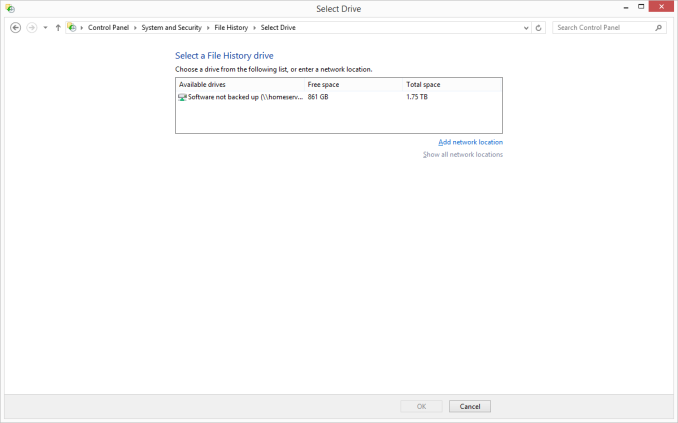
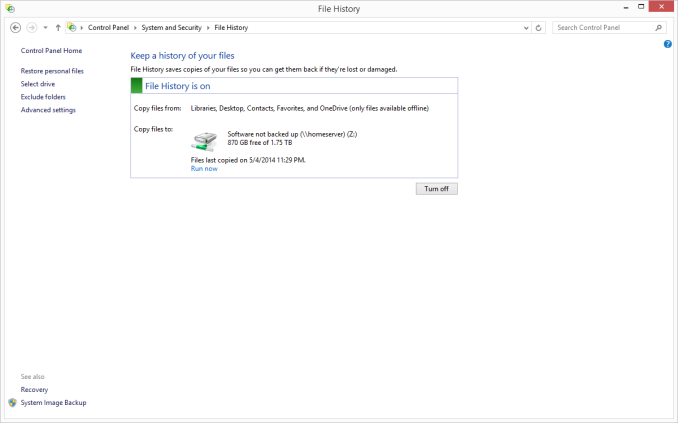
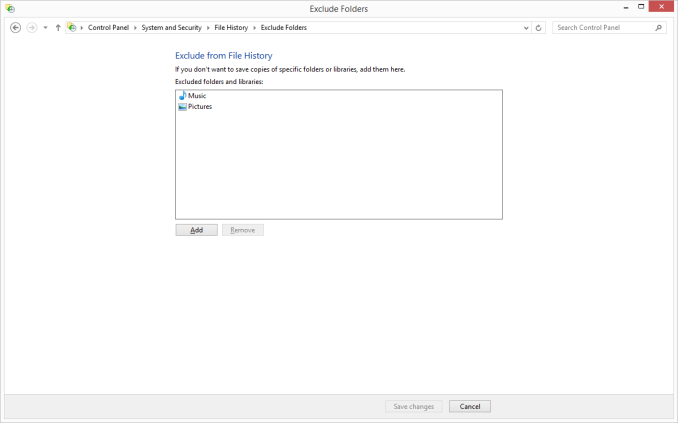
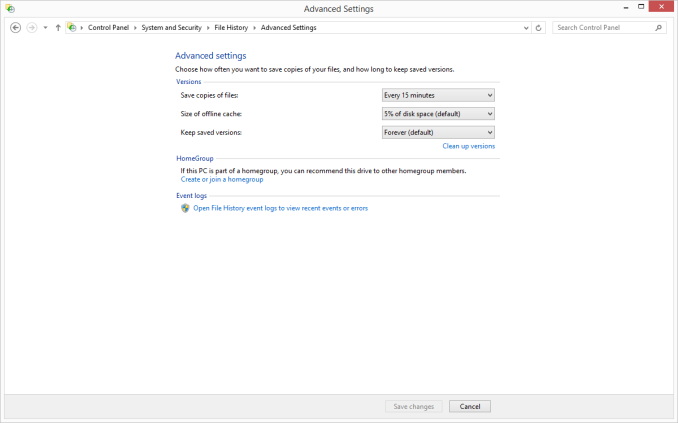





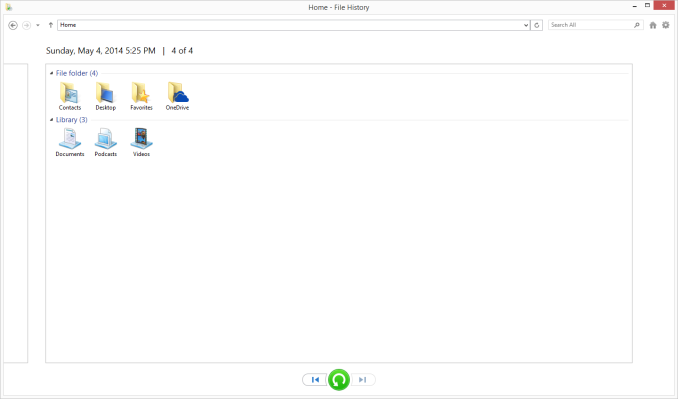










133 Comments
View All Comments
gcoupe - Wednesday, May 21, 2014 - link
Well, to be fair WHS 2011 is not yet "defunct". It is in mainstream support until April 2016:http://support.microsoft.com/lifecycle/search/defa...
However, I agree that it is a crying shame that Microsoft has left the home server market to wither on the vine. WHS was a good product. WHS 2011 was not the advance over the original that it should have been, because of Microsoft organizational politics. Still, it was a real bargain at $40. Windows Server Essentials 2012 is too expensive for home users to even consider.
peterfares - Wednesday, May 21, 2014 - link
I agree. I Use Windows Server 2012 R2 because I got a license from DreakSpark but there is absolutely no way I'd consider buying that for home server use. I'd probably just run a client version of Windows and use third party programs to handle backups. It's unfortunate that they removed automatic system image backups from Windows 8.1kmmatney - Wednesday, May 21, 2014 - link
WHS 2011 with Stablebit DrivePool has been working for me. I plan on keeping it a while, but after that I'll just figure out a way to pretty a regular version of Windows on the machine, and third party central backup programs. I also use my WHS server as a Minecraft server, and media server.SirGCal - Wednesday, May 21, 2014 - link
100 GB - $241 TB / $120
10 TB / $1200
20 TB / $2400
300 TB / $3600
Don't you mean 30TB, not 300TB? For Google Drive on 'Consumer Cloud and What I Do' page? If not, then 300TB is for sure the way to go. What a savings...
Brett Howse - Wednesday, May 21, 2014 - link
Yes I did fixed tyvm!Guinpen - Wednesday, May 21, 2014 - link
No mention of options for Linux? Why?Brett Howse - Wednesday, May 21, 2014 - link
I mentioned Crashplan has a Linux client. I don't use Linux on my home computers, and neither do most people, so I didn't discuss it for the most part.wumpus - Thursday, May 22, 2014 - link
I plan on backing up my cousin's windows computer (I owe him one, otherwise highly not recommended). Best I can tell, the way to do this (especially if you have some handy drives that will store the data compressed, but not uncompressed) is to install Linux on some removeable drives (OpenSUSE looks promising, see below) and then use the dd command to copy the windows drive completely as an image to the Linux external drive (this gives you the option to either copy the entire system back (with everything already installed) or to mount the file with -loopback and copy individual files). Note that you will likely want a compressed linux drive (to save space). This looks easiest with btfs (thus Opensuse, and don't forget the forcing option otherwise the compressor will give up before it hits all that empty space). Using this system for incremental backups requires a bit of programming (but is surprisingly easy with pyfuse).Quite frankly, the dd "disk destroyer" command is so famous to get wrong (and thus write empty sectors over what you wanted to back up) that I would be afraid to include step by step instructions in something like this. You have been warned.
It would be nice to see if you could back up with something like Anaconda, especially for free.
peterfares - Wednesday, May 21, 2014 - link
Ah sweet I didn't know there was still a GUI method for doing a system backup in Windows 8.1! I thought you had to use wbadmin. I was wondering why the Windows 8.1 recovery still supported system image restores when I thought there was no way to create a system image without the command line.Anyways for previous versions on Windows 8.1: they're still there! Just the tab is not shown for local drives. If you access a network share you can still see the previous versions of files done with Volume Shadow Copy. Turn on system recovery for all your hard drives (it's on for the system drive as default) and then access your own computer via it's UNC path (\localhost\C$ or whatever other share you want to access). Then when you press properties on folder or file the previous versions tab is present!
Another way to access volume shadow copies of files is to use ShadowExplorer.
peterfares - Wednesday, May 21, 2014 - link
More details http://winhowto.blogspot.com/2012/09/windows-8-how...